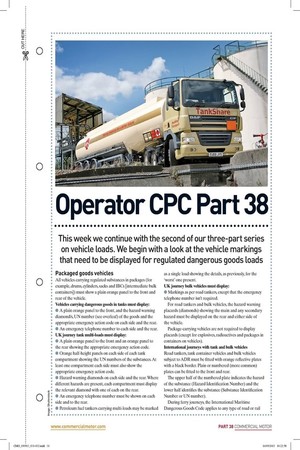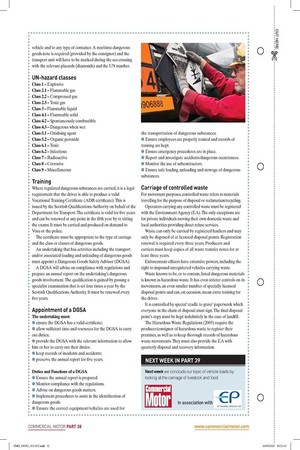Operator CPC Part 38
Page 23

Page 24

If you've noticed an error in this article please click here to report it so we can fix it.
This week we continue with the second of our three-part series on vehicle loads. We begin with a look at the vehicle markings that need to be displayed for regulated dangerous goods loads
Packaged goods vehicles
All vehicles carrying regulated substances in packages (for example, drums, cylinders, sacks and IBCs [intermediate bulk containers]) must show a plain orange panel to the front and rear of the vehicle. Vehides carrying dangerous goods in tanks must display:
• A plain orange panel to the front, and the hazard warning diamond/s, UN number (see overleaf) of the goods and the appropriate emergency action code on each side and the rear. • An emergency telephone number to each side and the rear. UK journey tank multi-loads must display:
• A plain orange panel to the front and an orange panel to the rear showing the appropriate emergency action code.
• Orange half-height panels on each side of each tank compartment showing the UN numbers of the substances. At least one compartment each side must also show the appropriate emergency action code.
• Hazard warning diamonds on each side and the rear. Where different hazards are present, each compartment must display the relevant diamond with one of each on the rear.
• An emergency telephone number must be shown on each side and to the rear. • Petroleum fuel tankers carrying multi-loads may be marked
as a single load showing the details, as previously, for the 'worst' one present. UK journey bulk vehicles must display:
• Markings as per road tankers, except that the emergency telephone number isn't required.
For road tankers and bulk vehicles, the hazard warning placards (diamonds) showing the main and any secondary hazard must be displayed on the rear and either side of the vehicle.
Package-carrying vehicles are not required to display placards (except for explosives, radioactives and packages in containers on vehicles).
International journeys with tank and bulk vehicles Road tankers, tank container vehicles and bulk vehicles subject to ADR must be fitted with orange reflective plates with a black border. Plain or numbered (more common) plates can be fitted to the front and rear.
The upper half of the numbered plate indicates the hazard of the substance (Hazard Identification Number) and the lower half identifies the substance (Substance Identification Number or UN number). During ferry journeys, the International Maritime Dangerous Goods Code applies to any type of road or rail
vehicle and to any type of container. A maritime dangerous goods note is required (provided by the consignor) and the transport unit will have to be marked during the sea crossing with the relevant placards (diamonds) and the UN number.
UN-hazard classes
Class 1— Explosive Class 2.1— Flammable gas Class 2.2 — Compressed gas Class 2.3— Toxic gas Class 3 — Flammable liquid Class 4.1— Flammable solid Class 4.2— Spontaneously combustible Class 4.3 — Dangerous when wet Class 5.1— Oxidising agent Class 5.2— Organic peroxide Class 6.1— Toxic Class 6.2— Infectious Class 7 — Radioactive Class 8— Corrosive Class 9— Miscellaneous
Training
Where regulated dangerous substances are carried, it is a legal requirement that the driver is able to produce a valid Vocational Training Certificate (ADR certificate). This is issued by the Scottish Qualifications Authority on behalf of the Department for Transport. The certificate is valid for five years and can be renewed at any point in the fifth year by re-sitting the exams. It must be carried and produced on demand to Vosa or the police.
The certificate must be appropriate to the type of carriage and the class or classes of dangerous goods.
An undertaking that has activities including the transport and/or associated loading and unloading of dangerous goods must appoint a Dangerous Goods Safety Advisor (DGSA).
A DGSA will advise on compliance with regulations and prepare an annual report on the undertaking's dangerous goods involvement. The qualification is gained by passing a specialist examination that is set four times a year by the Scottish Qualifications Authority. It must be renewed every five years.
Appointment of a DGSA
The undertaking must • ensure the DGSA has a valid certificate; • allow sufficient time and resources for the DGSA to carry out duties; • provide the DGSA with the relevant information to allow him or her to carry out their duties; • keep records of incidents and accidents;
• preserve the annual report for five years.
Duties and Functions of a DGSA
• Ensure the annual report is prepared.
• Monitor compliance with the regulations.
• Advise on dangerous goods matters.
• Implement procedures to assist in the identification of dangerous goods. • Ensure the correct equipment/vehicles are used for
the transportation of dangerous substances.
• Ensure employees are properly trained and records of training are kept.
• Ensure emergency procedures are in place.
• Report and investigate accidents/dangerous occurrences.
• Monitor the use of subcontractors.
• Ensure safe loading, unloading and stowage of dangerous substances.
Carriage of controlled waste
For movement purposes, controlled waste refers to materials travelling for the purpose of disposal or reclamation/recycling.
Operators carrying any controlled waste must be registered with the Environment Agency (EA). The only exceptions are for private individuals moving their own domestic waste and local authorities providing direct refuse services.
Waste can only be carried by registered hauliers and may only be disposed of at licensed disposal points. Registration renewal is required every three years. Producers and carriers must keep copies of all waste transfer notes for at least three years.
Enforcement officers have extensive powers, including the right to impound unregistered vehicles carrying waste.
Waste known to be, or to contain, listed dangerous materials is known as hazardous waste. It has even stricter controls on its movements, an even smaller number of specially licensed disposal points and can, on occasion, mean extra training for the driver.
It is controlled by special 'cradle to grave' paperwork which everyone in the chain of disposal must sign. The final disposal point's copy must be kept indefinitely in the case of landfill.
The Hazardous Waste Regulations (2005) require the producer/consignor of hazardous waste to register their premises, as well as to keep thorough records of hazardous waste movements. They must also provide the EA with quarterly disposal and recovery information.







































